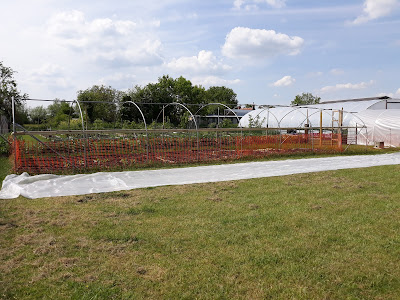Neither of us have either worried about learning through trial and error, after all that is often the only way to learn when you are doing something new, to make a mistake and to learn from it. But when mistakes are caused by something that you almost could never have seen coming then it feels like really you are fighting a losing battle, and you ask at what point has it become just too hard.
It is now several days on and I feel that I can write a blog post, that's exactly what Dr Philip Morley, the Technical Officer for the British Tomato Growers’ Association said we would feel like - it will take a few days to regroup then you will find a way of how to move through this he said. He was right, slowly we are coming to terms with how to deal with our growing area, including our large polytunnel that have become contaminated with a silent destroyer, a potent herbicide known by the name of Aminopyralid.
The first signs that something wasn't right was when the new growth on the Alicante and Gardeners Delight tomatoes started to curl up and look deformed. This was something that happened last year and we couldn't work out why - eventually the plants grew through it, but never really recovered and the fruit off them was never really plentiful.
The damage is very obvious, especially when you compare it to a healthy plant...
Untouched plants growing in our tubs, have beautiful fresh green growth, broad leaves and an abundance of flowers, compared to the gnarled twisted and deformed growth of the affected plants.
As soon as we started to see the first signs on the tomatoes we then started to see the new potatoes going the same way.
And again when compared with a plant not affected, the distortion is made even more obvious.
Our hearts sank, were we going to see a repeat of last year, when this similar deformity affected all our beans as well, with our 200 runner plants hardly bearing any fruit at all. Before we hit the panic button, especially with all the tomatoes we had planned and the early runners we had been nuturing, I took some photos and wrote a few emails, one of which was to the British Tomato Growers Association.
Phil Morley, replied almost instantly, he had certainly seen the symptoms before and after what we had told him he suspected that it was the presence of residual herbicide. Knowing also that we had been bringing in farmyard manure to lighten, improve and boost up our soil this material can be a carrier of such a poison. Aminopyralid herbicides persist in pasture once applied, and then incredibly persist even through the gut of the animal and remain persistent through composting. It was very frightening to learn that contamination levels in compost as little as 2 parts per billion have a significant physiological/metabolic effect on plants such as tomatoes, potatoes and beans. Such species are highly sensitive to such contamination which causes virus like symptoms of miss-shaped plant growing points and lack of fruit set.
It was almost unbelievable, but explained many episodes from the year before, we felt sick, but if we needed further evidence we only had to look at our early dwarf beans - not exactly healthy specimens.
After a very helpful chat with Phil Morley, he went on further to explain that it can have devastating effects, wiping out entire crops. 'Key symptoms are distorted leaves and growing tips on tomatoes, potatoes and other veg affected by the herbicide. This is a particularly potent herbicide. It does not degrade in composting, it is found in hay, grass and silage cut from sprayed fields and the chemical passes through feeding animals into their manure.
Aminopyralid was approved for use in the UK in 2005 as a herbicide that targets mainly broadleaved weeds including ragwort. It didn’t take long before allotment associations were reporting catastrophic damage caused by people using contaminated composted manures on their plots. Use was suspended in 2008 and new legislation brought in, the theory being to prevent the herbicide from leaving the land where it was sprayed and contaminating other land.
However, the problem did not go away. In 2011 George Monbiot wrote an article explaining some of the serious consequences of the herbicide and called for a suspension of sales, but that didn’t happen. It has continued to be a problem for growers and gardeners alike, which has increased significantly in recent years.
The only way to beat this contamination and deal with it is pretty much down to time, it is broken down by soil organisms and microbes, how long this takes can depend on the intensity of the contamination, but it can take years.
With our whole planting plan now blown out of the air, we ran around like headless chickens for a few days, with a very limited attention span, hard to know what was a priority and what to focus on. But as time has passed, we have gained clarity and adapted our approach - Plan B all round for all the vulnerable species - and to achieve this we need to squeeze more out of everyday if possible.
However, when we look back, one of the real positives of this whole experience that we have to mention, has to be the amazing people that we have met electronically. We have mentioned Phil from the British Tomato Growers' Association, but we have also had speedy and good advice from Valley Grown Salads, The Tomato Stall, Eric Wall Nursery and Charles Dowding, the latter who has so much experience of this hateful herbicide: 'We need to stop this'. These dedicated folk have helped us through a period which has been extraordinarily difficult - at what was a challenging time before we encountered this.




















































